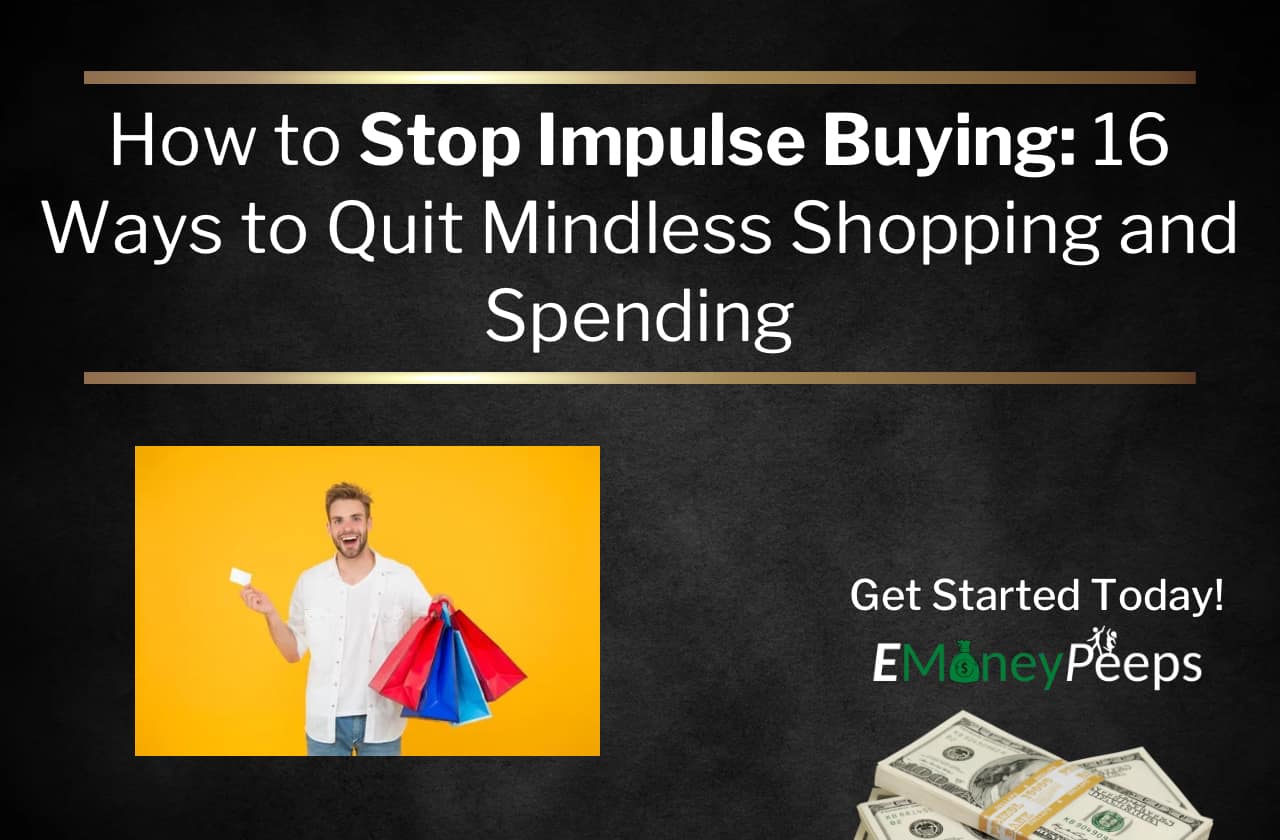How to Stop Impulse Buying: 16 Ways to Quit Mindless Shopping and Spending

Do you find yourself constantly tempted by the latest trends, deals, and shiny new products, only to end up with buyer’s remorse and an ever-growing pile of unused items?
If so, you’re not alone. Impulse buying is a common struggle that many people face in our consumer-driven society.
But the good news is, there are strategies you can implement to break the cycle of mindless shopping and regain control over your spending habits.
In this article, we’ll share 16 effective ways on how to stop impulse buying and cultivate more mindful purchasing behaviors.
1. Get Serious With Your Budget
Getting serious with your budget is the best first step you can take if you’re serious about getting your mindless spending under control.
I learned the hard way that those little impulse purchases add up fast—fancy coffees, quick meals out, or random online buys.
It didn’t feel like much at the time, but looking back, I was easily spending $50 a day on things I didn’t need. In just one month, that adds up to over $1,500!
It’s easy to lose track of how much you’re actually spending day-to-day, and those impulse buys can completely derail your budget, especially when you’re working toward bigger financial goals.
Luckily, there are some fantastic budgeting apps that can help you keep things in check. Apps like Mint, YNAB (You Need a Budget), and PocketGuard make it easy to see where your money is going in real-time and alert you when you’re approaching your spending limits.
I found that setting daily spending limits on these apps was a game-changer. When you track every dollar, you start thinking twice before making those spur-of-the-moment purchases.
Getting serious with your budget takes a little commitment, but with the right tools, it becomes so much easier to take control of your finances and start building healthier spending habits.
25 Tips For How To Save Money If Your Paycheck Is Stretched Thin

2. Understand Your Triggers
The next step to curbing impulse purchases is to identify the triggers that lead you to overspend.
Are you more tempted to shop when you’re feeling bored, stressed, or emotional?
Do certain types of sales or marketing tactics make you want to hit the “add to cart” button? Knowing your personal triggers can help you develop a plan to avoid or manage them.
Write down your triggers, and ways you are going to avoid them. Then every day read through this and keep it focused in your mind.
Writing down this plan of action and reading it everyday, will help you stop habits of impulse buying.

3. Track Your Daily Spending
Tracking your daily spending is a powerful way to gain control over your finances and cut down on impulse buying.
By keeping a close watch on where every dollar goes, you become more aware of spending patterns and can spot areas where money may be slipping through your fingers.
This habit allows you to differentiate between essential expenses and unnecessary purchases, making it easier to avoid those tempting, impulsive buys that often derail budgets.
Tracking spending not only helps save money but also builds financial discipline, giving you a clearer path to achieving larger financial goals and ultimately helping you make more intentional choices with your money.
This is where budgeting apps can help you track as well.

4. Create a Waiting Period
Whenever you’re tempted to make an unplanned purchase, impose a mandatory waiting period of 24-48 hours before following through.
This simple technique allows the initial excitement to subside, giving you time to evaluate whether the item is truly necessary or a good use of your money.
5. Stay Out of Gas Stations
This one is simple, many people blow their budget spending needlessly on impulse buys every time they step foot in a gas station. So use your card at the pump, and be on your way.
It’s that easy…
I once helped one of my friends rein in his impulse spending, and when I looked at his receipts, I could not believe how much money he spent every time he entered a gas station.
It was over $600 a month, not including his gas.
6. Make a Shopping List (and Stick to It)
Before heading to the store or browsing online, take a moment to make a thoughtful shopping list.
Stick to the items you’ve carefully considered and planned for, resisting the urge to deviate from your list, no matter how enticing the other options may be.
Tip; don’t go grocery shopping hungry, you will way over spend and buy more convenience food items.
7. Avoid Browsing and Unsubscribe
Reduce your exposure to temptation by limiting your time spent browsing stores, both in-person and online.
Unsubscribe from promotional emails, mailing lists, and social media accounts that regularly bombard you with sales and product recommendations.
8. Block Favorite Shopping Sites on Your Devices
Take it a step further and block your favorite shopping sites on your devices, this can be a game-changer for curbing impulse purchases.
When you find yourself mindlessly browsing through online stores, it’s all too easy to make unplanned purchases, especially when everything is just a few clicks away.
By setting up blockers for these sites on your phone, tablet, or computer, you add an extra layer of friction that can help break the habit of impulse shopping.
There are apps and browser extensions like StayFocusd, Freedom, or even built-in screen time settings that allow you to restrict access to specific websites.
This simple step can help you avoid temptations, refocus on your budget goals, and build better financial habits by keeping those unnecessary expenses at bay.

9. Practice the 30-Day Rule
When you’re considering a purchase that isn’t an absolute necessity, implement the 30-day rule.
Wait 30 days before making the buy, and if you still feel it’s a worthwhile investment after that time, then proceed.
This helps ensure you’re not making an impulsive decision.
10. Use the 10-Minute Rule
If you’re struggling to resist an impulse purchase, try the 10-minute rule. When you feel the urge to buy something, wait 10 minutes before taking any action.
Use this time to reflect on whether you truly need the item and whether it aligns with your financial goals.
The Procrastination Cure: 10 Steps to Break Your Bad Habits
11. Adopt the One-In, One-Out Policy
Whenever you bring a new item into your home, commit to removing one item that you no longer need or use.
This encourages you to be more mindful about your purchases and helps prevent clutter from accumulating.
12. Avoid Temptation Zones
Be strategic about your shopping habits by avoiding areas or stores that are known to trigger your impulse purchases.
If possible, steer clear of the mall or big-box retailers, and stick to your necessities-focused shopping destinations.

13. Carry Only Cash (and Leave the Cards at Home)
Leaving your credit and debit cards at home and carrying only cash can make it much harder to overspend.
The physical act of handing over cash can create a stronger psychological connection to the money you’re spending, making you more mindful of your purchases.
14. Seek Accountability
Enlist the support of friends, family, or a financial advisor to help you stay accountable to your spending goals.
Regularly sharing your progress and challenges can provide the motivation and encouragement you need to stick to your goals.
15. Practice Gratitude and Contentment
Cultivate a mindset of gratitude and contentment with what you already have.
When you’re feeling grateful for the possessions and experiences in your life, you’ll be less likely to seek fulfillment through material goods.
16. Find Fulfillment in Non-Buying Activities
Redirect your energy and focus towards hobbies, social connections, and experiences that don’t involve spending money.
Explore new ways to find joy, relaxation, and personal growth that don’t rely on shopping as a coping mechanism.

When Impulsive Buying Becomes a Bigger Issue
While occasional impulse purchases are common, if your shopping habits start to interfere with your financial well-being, relationships, or overall quality of life, it may be time to seek additional support.
Signs that impulsive buying has become a more significant problem include:
- Regularly exceeding your monthly budget or accruing debt due to unplanned purchases
- Feelings of guilt, shame, or anxiety after making impulse buys
- Neglecting other important responsibilities (work, family, self-care) in favor of shopping
- Hiding or lying about your spending habits
- Experiencing withdrawal symptoms or cravings when you’re unable to shop
If you recognize these patterns in your own life, consider reaching out to a financial counselor, therapist, or support group that specializes in addressing compulsive spending behaviors.
With the right guidance and coping strategies, you can break the cycle of impulse buying and regain control over your financial and emotional well-being.
How To Get Out Of Debt Fast In 8 Steps
Breaking the Habit: How to Stop Impulse Buying
Remember, breaking the habit of impulse buying takes time and consistent effort. Be patient with yourself, celebrate your small wins, and don’t be too hard on yourself when you slip up.
With these strategies in your toolkit, you can regain control over your spending and enjoy the benefits of a more mindful, fulfilling lifestyle.
We really hope this article on How to Stop Impulse Buying: 16 Ways to Quit Mindless Shopping and Spending has been extremely helpful to you.
If you have any questions, don’t hesitate to post them in the comments section below or just say hello.
Sincerely,
Your Friends And Partners
Richard And John Weberg

Copyright Notice: If this content is reproduced in full on any other website other than EmoneyPeeps.com, it is without our permission, and is copyright infringement. We own all rights to this article. Any attempts to infringe the website content will result in strict legal actions. You are free to link to any article on our website, but not copy our content.

